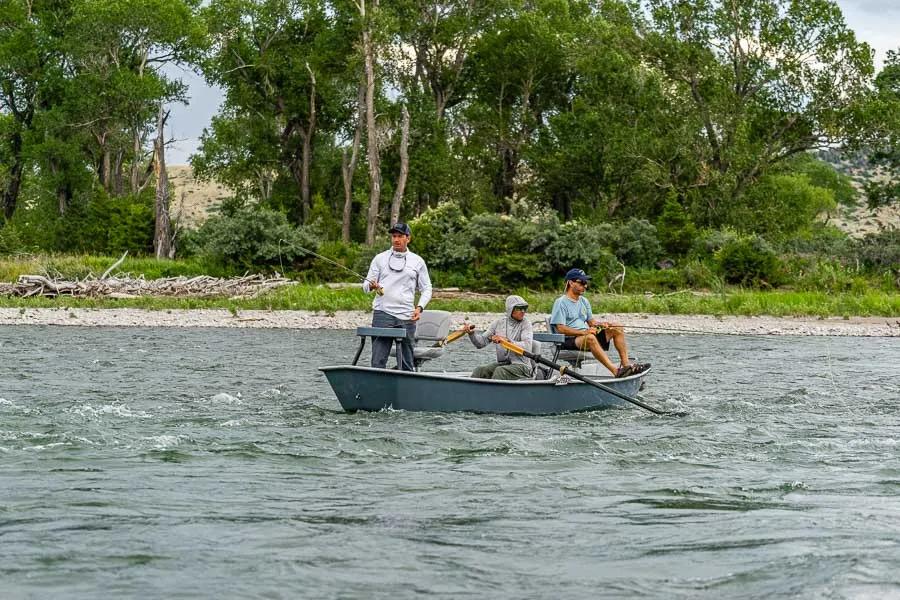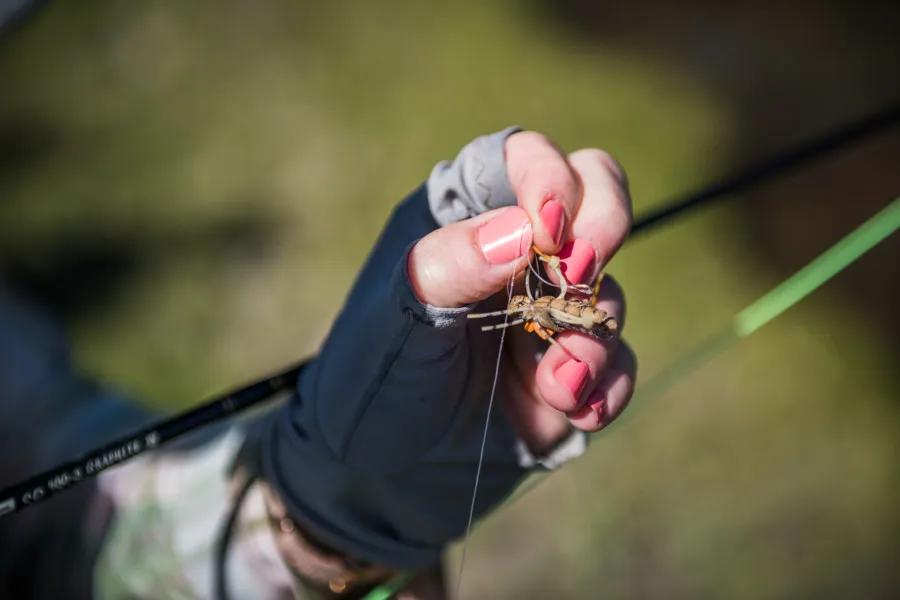
Late summer in Montana brings some of the most highly anticipated dry fly fishing of the season: "hopper fishing!". Montana's numerous large agricultural valleys filled with alfalfa fields are a haven for the large insects. Although grasshoppers fill the fields in the early summer, trout do not get interested in them until they molt from the nymph stage to and adult stage. As adult insects, hoppers have wings allowing them to become airborne. Because they are not strong fliers, they can be easily diverted into rivers, especially on windy days. Afternoon winds on sunny days are a daily occurrence as warm valley bottom air rushes upriver to replace the cooler air in the headwaters. The combination of lots of grasshoppers with breezy afternoons results in some of the world's best hopper fishing. The large size of a typical grasshopper sometimes induces larger trout to the surface, and the size of the fish combined with the often exciting takes produces some of the year's most satisfying surface fishing. Follow these five tips to improve your odds during hopper time.
Tip 1: Don't give up on hoppers, try them throughout the day
Hopper fishing is usually very slow in the mornings, but can improve dramatically as the day warms and the winds pick up. Grasshoppers do not become active until the morning warms and the dew burns off the grass. Some days fish are on hoppers much more than others and they can quickly turn from off to on. Don't make the mistake of trying hoppers early in the day and then give up on them because they aren't producing. I prefer to have a hopper rod strung up and waiting on float trips so that we can test it every half hour. Anytime it gets very windy, it is almost a given that fish will eventually turn onto hoppers at some point in the afternoon. Pay special attention to crosswinds as these produce the best hopper winds of all.

Tip 2: Avoid the tendency to focus exclusively on the banks
The classic hopper cast that everyone envisions is to splat a hopper a few inches from an undercut bank and watch as a giant brown rushes from his lie to crush your fly. While there are definitely a lot of fish on the banks looking for hoppers, there are several reasons why only casting at the banks on a Montana float fishing trip is not always the best strategy. First, strong hopper winds will blow the insects to all reaches of the river, not just the banks so most of the trout in the river will eat them (not just trout on the banks). Second, the best trout habitat in the late summer months is not always bank habitat. This varies greatly from river to river, or from run to run. As rivers drop in the summer, some of the undercuts banks become marginal or disappear completely as the river recedes from the banks. Under these conditions, the majority of the trout will move off the banks into other habitat areas like around boulders, into riffles or into glides. It pays to fish were the trout are. The third reason to fish other water besides banks, is that fisherman are conditioned to cast hoppers at banks. On rivers that receive even moderate pressure, trout have seen more than their fair share of foam hoppers drifted overhead within two or three weeks of hopper seasons beginning. The trout that are a holding in other positions in the river have seen far fewer hoppers and are more likely to fall for your imitation.

Tip 3: Give your hoppers action
Sometimes trout want to see a hopper twitching. This is especially true on some of the more famous Montana fishing rivers later during the hopper season. Once a trout has had a bad experience with an artificial, they become a little more selective with their takes. Natural hoppers kick and swim aggressively to get back to the banks. Several years ago, I had some clients fishing a small trophy trout reservoir in the middle of August. Normally the fishing is best in the morning, and gets more difficult as the day progresses and the fish go deeper. After a great morning of site fishing with nymphs, it had appeared that the fish had moved to deeper water. After lunch, we moved to a different reservoir to give it a try. While to launch the drift boat, I saw the hoppers that I was flushing out of the bushes getting blown into the pond by a very stiff crosswind. An idea struck me, and began running up and down the bank flushing hoppers out of the sage brush. Within a few minutes hundreds of hoppers were kicking for their lives while 24" trout left wakes across the water as they bull rushed the defenseless arthropods. We quickly launched the boat and enjoyed a ten minute window of great fishing until the surviving hoppers all made it back to the banks. We repeated the process for an hour an a half, each round producing a monster trout or two. I was amazed how aggressively the hoppers in the water were swimming and how quickly they were able to make it out of the water.
One of the ways that selective trout differentiate between real hoppers and an angler's imitations is the presence of motion. By twitching your flies periodically, you can often produce many more strikes than a dead drift. This is especially effective later in hopper season. The best way to twitch hoppers is with a micro mend combined with a very short strip. The strip causes the hopper to twitch and the small mend allows the hopper to immediately dead drift after the twitch. With practice, it is possible to get the hopper twitching almost continuously across the surface.
Tip 4: Be patient with your hook set
There are two types of hopper strikes, the aggressive bull rush and the relaxed sip. On an aggressive bull rush takes you should set the hook quickly and aggressively. These type of strikes often occur when you twitch your hopper. Since the fish has entirely engulfed your fly, there is no need to be patient with the set. On the slow sipping takes which are very common when fishing hoppers, a quick set normally results in a missed fish. Often trout will come up right behind a hopper and actually put their snout right under the fly before sucking it under. On these slow and casual takes you will get a much higher hook-up percentage be delaying your set by at least one full second. A Canadian friend of mine that guides on Alberta's Bo River gave me some great advice for hopper fishing: repeat the phrase "God save the Queen" before setting the hook.

Tip 5: Try different hopper patterns and sizes
Montana fly fishing guides know that grasshoppers come in a variety of different sizes and colors. If you look in any guides terrestrial box, you will undoubtedly see at least a dozen compartments devoted to hoppers from size 10 to 4. I have noticed that most out of state anglers always default to smaller flies when given a choice. This is probably because they have been conditioned to highly pressured trout on their home rivers that don't respond well to large flies. Montana trout still see light pressure compared to fisheries in almost every other state in the lower 48 and they will still eagerly eat big bugs. One of my favorite strategies is to fish two hoppers on the same rod. We will fish a size 6 as our top fly and drop a smaller size 10 about 18 inches behind. On many days the larger pattern out fishes the smaller hopper.

Late summer hopper fishing across Montana's larger blue ribbon rivers and smaller meadow streams is cherrished by every angler that enjoys fly fishing in the Big Sky state. Upon first glance the prospects of slapping a big foam hopper on the water may not seem that sophisticated, there are a definetly a variety of technical elements to fishing these large terrestrials. By paying attention to some of the nuances when fly fishing with hopper patterns, you can increase your odds for both success and satisfaction.
